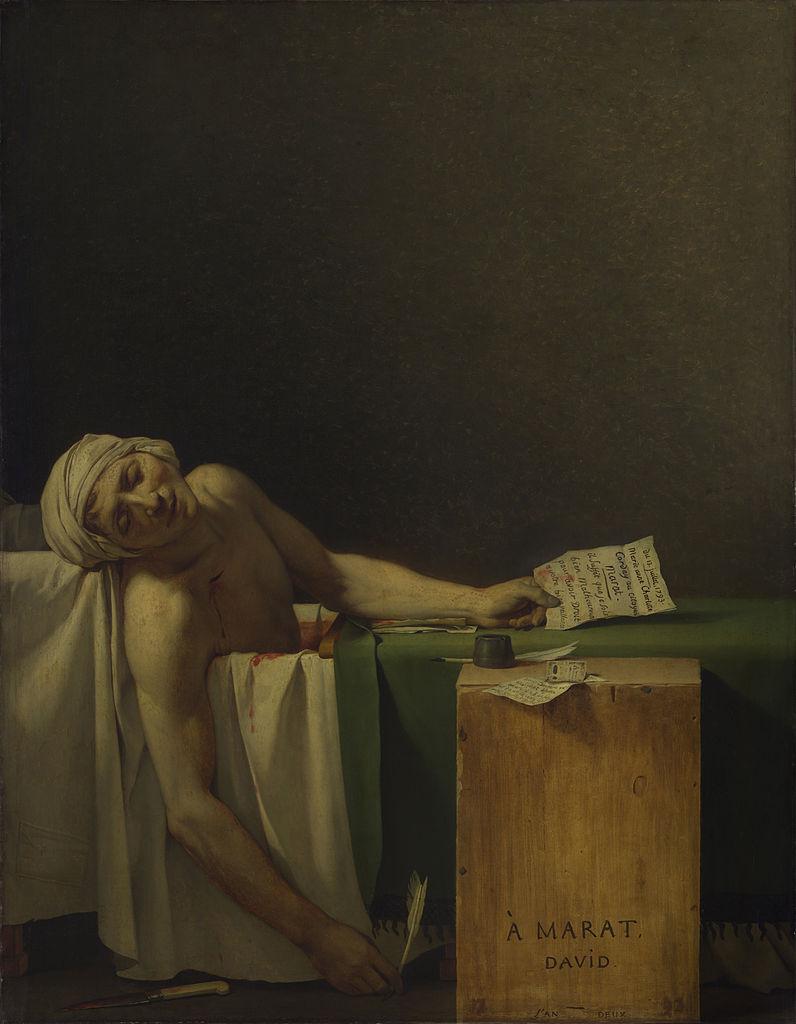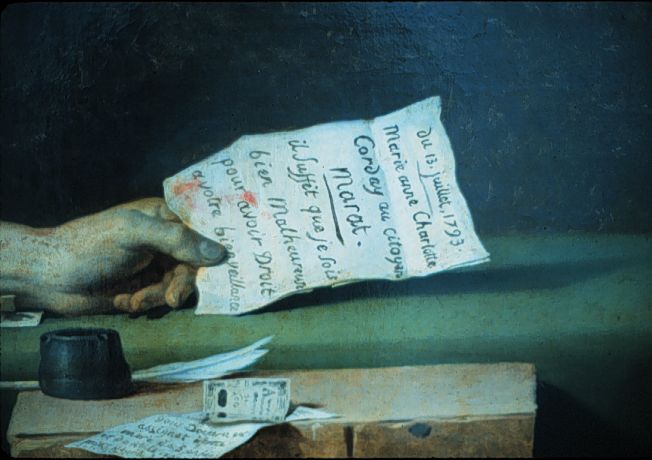9.11: La muerte de David de Marat
- Page ID
- 102847
Para 1793, la violencia de la Revolución aumentó dramáticamente hasta que las decapitaciones en la Plaza de la Concordia se convirtieron en una constante, llevando a cierto Dr. Joseph Guillotina inventar una máquina que mejoraría la eficiencia del hacha y bloquearía y por lo tanto haría más humanas las ejecuciones. David estaba metido en eso. Al principio de la Revolución se había unido a los jacobinos, club político que con el tiempo se convertiría en el más rabioso de las diversas facciones rebeldes. Liderados por el desventurado Georges Danton y el infame Maximilien Robespierre, los jacobinos (incluido David) eventualmente votarían para ejecutar a Luis XVI y a su reina María Antionette que fueron sorprendidos intentando escapar a través de la frontera hacia el Imperio austríaco.


En el apogeo del Reinado del Terror en 1793, David pintó un monumento a su gran amigo, el editor asesinado, Jean Marat. Al igual que en su Muerte de Sócrates, David sustituye la iconografía (formas simbólicas) del arte cristiano por temas más contemporáneos. La muerte de Marat, 1793 se muestra una imagen idealizada del amigo asesinado de David sosteniendo la carta de presentación de su asesina (Charlotte Corday). El cuchillo ensangrentado yace en el suelo habiendo abierto una herida fatal que funciona, al igual que la misma composición de Marat, como una referencia al entierro de Cristo y una especie de estigmas secularizados (referencia a las heridas que se dice que Cristo recibió en sus manos, pies y costado mientras estaba en la cruz). ¿Está tratando David ahora de encontrar mártires revolucionarios para reemplazar a los santos del catolicismo (que habían sido proscritos)?
Para 1794 el Reinado del Terror había corrido su curso. Los jacobinos habían comenzado a ejecutar no sólo aristócratas capturados sino también a compañeros revolucionarios. Eventualmente, el propio Robespierre moriría y los jacobinos restantes también fueron ejecutados o encarcelados. David escapó de la muerte renunciando a sus actividades y fue encerrado en una celda del antiguo palacio, el Louvre, hasta su eventual liberación por el nuevo gobernante de Francia, Napoleón Bonaparte. Este diminutivo corso había sido el general más joven del ejército francés y durante la Revolución se había convertido en un héroe nacional al librar una serie aparentemente interminable de campañas militares victoriosas contra los austriacos en Bélgica e Italia. Eventualmente, Napoleón controlaría la mayor parte de Europa, se coronaría Emperador y liberaría a David en reconocimiento de que el talento del artista podría servir a los propósitos del gobernante.
Colaboradores
- La muerte de David de Marat. Proporcionado por: Khan Academy. Ubicado en: https://web.archive.org/web/20130425092955/http://smarthistory.khanacademy.org/david-death-of-marat.html. Licencia: CC BY-NC-SA: Atribución-NoComercial-CompartirIgual
- Jacques-Louis David, La muerte de Marat. Autor: Dra. Beth Harris y Dr. Steven Zucker. Proporcionado por: Khan Academy. Ubicado en: www.khanacademy.org/humanities monarchy-lightenment/neo-classicism/v/david-marat. Licencia: CC BY-NC-SA: Atribución-NoComercial-CompartirIgual

